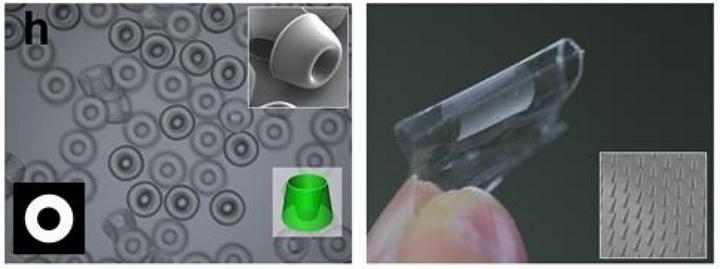 Diffusion describes the fact that molecules, vibrating with random motion in a gas or liquid, move toward a state of equilibrium where those molecular species in a mixture are uniformly dispersed until the concentration of any one species becomes the same throughout the medium. It’s a sort of Fick’s second law issue, and Fick’s laws have been used to model transport processes in foods, neurons, biopolymers, pharmaceuticals, porous soils, and nuclear materials.
Diffusion describes the fact that molecules, vibrating with random motion in a gas or liquid, move toward a state of equilibrium where those molecular species in a mixture are uniformly dispersed until the concentration of any one species becomes the same throughout the medium. It’s a sort of Fick’s second law issue, and Fick’s laws have been used to model transport processes in foods, neurons, biopolymers, pharmaceuticals, porous soils, and nuclear materials.
It’s an understanding of that law that has led Professor Shin-Hyun Kim and a team of researchers working at the Department of Chemical and Biomolecular Engineering within the Korea Advanced Institute of Science and Technology (KAIST) to develop a novel, photolithographic technology that uses oxygen diffusion to control the creation of functional, 3D micropattern shapes.
Photolithography is an optical process for transferring micropatterns to various substrates by exposing specific regions of what’s called the “photoresist” layer to an ultraviolet light source. Industries that require such micropatterns, such as semiconductor manufacture, relied on photomasks.
These photomasks protect specific regions of the substrate from the input UV light, and locations covered by the photomask remain intact as areas exposed to the UV light are washed away. Until now, this technology was limited to fabricating two-dimensional, disc-shaped designs. The problem with creating any other types of shapes occurs because the boundaries between the exposed and covered regions are in a parallel arrangement with the direction of the UV light.
What Kim’s team discovered is a two-fold observation: areas exposed to UV light lowered the concentration of oxygen in that area, and manipulation of the diffusion speed and direction allowed control of the formation, shape, and size of the polymers.
This observation led them to a new photolithographic technology which enabled the production of micropatterns–with three-dimensional structures–in various shapes and sizes.
 Kim says that as oxygen was considered an inhibitor during photopolymerization, photoresist under UV light creates radicals which initialize a chemical reaction. He and his team eliminated these radicals by introducing the presence of oxygen to prevent the reaction.
Kim says that as oxygen was considered an inhibitor during photopolymerization, photoresist under UV light creates radicals which initialize a chemical reaction. He and his team eliminated these radicals by introducing the presence of oxygen to prevent the reaction.
According to Kim, he and his team exploited the presence of oxygen as they found that while the region affected by the UV light lowered oxygen concentration, the concentration in the untouched regions remained unchanged. When the speed of the oxygen flow is slow, the diffusion occurs in parallel with the direction of the UV light. When it’s sped up, the diffusion process develops horizontally and outward from the area affected by the UV light.
Kim and his team proved this phenomenon both empirically and theoretically, and by injecting an external oxygen source, the team found they could manipulate diffusion strength and direction to control the shape and size of the polymers within.
By using these polymerization inhibitors, they found it was possible to create complex, three-dimensional micropatterns.
“While 3D printing is considered an innovative manufacturing technology, it cannot be used for mass-production of microscopic products,” says Professor Kim. “The new photolithographic technology will have a broad impact on both the academia and industry especially because existing, conventional photolithographic equipment can be used for the development of more complex micropatterns.”
Kim says the research was dedicated to the late Professor Seung-Man Yang of the Department of Chemical and Biomolecular Engineering at KAIST. Professor Yang was considered one of the great scholars in Korea within the field of hydrodynamics and colloids.
Can this new photopolymerization process be considered 3D printing? Let us know your thoughts in the Oxygen Diffusion Technique forum thread on 3DPB.com.
Subscribe to Our Email Newsletter
Stay up-to-date on all the latest news from the 3D printing industry and receive information and offers from third party vendors.
You May Also Like
Gorilla Sports GE’s First 3D Printed Titanium Cast
How do you help a gorilla with a broken arm? Sounds like the start of a bad joke a zookeeper might tell, but it’s an actual dilemma recently faced by...
Nylon 3D Printed Parts Made More Functional with Coatings & Colors
Parts 3D printed from polyamide (PA, Nylon) 12 using powder bed fusion (PBF) are a mainstay in the additive manufacturing (AM) industry. While post-finishing processes have improved the porosity of...
$25M to Back Sintavia’s Largest Expansion of Metal 3D Printing Capacity Since 2019
Sintavia, the digital manufacturing company specializing in mission-critical parts for strategic sectors, announced a $25 million investment to increase its production capacity, the largest expansion to its operations since 2019....
Velo3D Initiates Public Offering in a Bid to Strengthen Financial Foundations and Drive Future Growth
Velo3D (NYSE: VLD) has been among a number of publicly traded 3D printing firms that have attempted to weather the current macroeconomic climate. After posting a challenging financial report for 2023,...

































